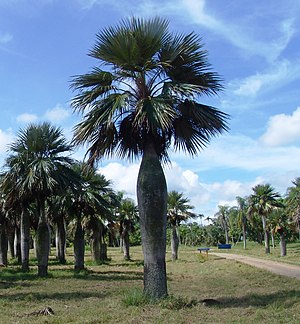Colpothrinax
| Colpothrinax | ||||||||||||
|---|---|---|---|---|---|---|---|---|---|---|---|---|

|
||||||||||||
| Systematics | ||||||||||||
|
||||||||||||
| Scientific name | ||||||||||||
| Colpothrinax | ||||||||||||
| Griseb. & H. Wendl. |
Colpothrinax is a genus of palm that is native to Central America and Cuba.
features
The representatives are moderately large, solitary, hermaphrodite, tree-shaped fan palms that bloom several times . The trunk is upright and initially covered with the fibrous leaf sheaths , later free. The trunk of Colpothrinax cookii is columnar, and of Colpothrinax wrightii strongly bulbous.
The number of chromosomes is unknown.
leaves
The leaves are induplicate folded and short costapalmat . The leaf sheath is frayed into a coarse, fibrous network or into long, fine, pendulous fibers. The petiole is long, flat or slightly furrowed on the top, rounded on the underside. The stalk edges are pointed and densely scaled. The adaxial hastula is clearly developed, triangular or irregularly lobed. The abaxial hastula is missing.
The leaf blade is circular and irregular, sometimes more than halfway divided into linear, simply folded segments. The segments are briefly bifid at the apex, thick, glabrous and wax-coated on the top, except along the ribs, which are scaled. The underside is densely covered with small scales.
Inflorescences
The inflorescences stand individually between the leaves (interfoliar), there are several at the same time. They are shorter than the leaves and branched up to four times. The peduncle is long and round in cross section. It is enclosed by overlapping bracts and densely hairy. The cover sheet is short, tubular, two-keeled at the side and tears open apically. There are four to nine bracts on the peduncle. They are tubed, single-keeled and tear open apically. The inflorescence axis is about the same length as the stem and just as hairy. There are several (usually 4 to 7) bracts that resemble those on the stem.
The lateral axes of the first order have a conspicuous, somewhat puffed-up, brown-haired double-keeled cover sheet and a similar empty bract. The following bracts are membranous, triangular, very small. The flower-bearing axes (rachillae) are protruding, densely hairy or bald and have small bracts in a spiral arrangement, which carry each individual, seated flower.
blossoms
The flowers are hermaphroditic. The calyx is cup-shaped, fleshy and has three short tips. The crown protrudes clearly beyond the calyx, is fleshy, tubular at the base and further up divided into three elongated valvate tips. These form a cap that falls off towards the flower. The crown can also be shorter than the chalice; then they do not include the stamens in the bud and do not fall off to flower. There are six stamens. Its filaments are fused at the base to form an epipetal cup, are connected to the corolla tube and are of the same length or slightly longer than this. The free filament parts are wide at the base and then greatly narrowed. The anthers are elongated, dorsifix near the base. The connective are very narrow.
There are three carpels that in the area of the ovary are free in the area of the elongated stylus grown. The scar is punctiform. The ovule is basal, upright and anatropic.
The pollen is ellipsoidal and mostly slightly asymmetrical. The germ opening is a distal sulcus.
Fruits and seeds
The fruit is spherical and usually develops from a carpel. It bears apical remains of scars and the remains of the abortive carpels. The perianth remains on the fruit. The exocarp is thin and smooth, the mesocarp is fleshy with anastomosing fibers that lie against the crusty endocarp . The seed is roughly spherical, not connected to the endocarp, except in the area of the small, basal navel (hilum). The raphe is as long as the seed, rather broad and without branches. The endosperm is homogeneous.
Systematics and distribution
The genus Colpothrinax Schaedtler is placed within the family Arecaceae in the subfamily Coryphoideae , tribe Trachycarpeae , but not assigned to any subtribe ( incertae sedis ). The monophyly of the genus has not yet been investigated.
In the World Checklist of Selected Plant Families of the Royal Botanic Gardens, Kew , the following types are recognized:
- Colpothrinax aphanopetala R.Evans : in Nicaragua, Costa Rica and Panama; in damp rainforests of the pre-montane and lower montane levels up to 1600 m.
- Colpothrinax cookii Read : in Belize, Guatemala, and Honduras; Sites such as C. aphanopetala .
- Colpothrinax wrightii Schaedtler : endemic to Cuba, mostly in semi-arid savannas and grasslands.
Colpothrinax was first described by August Grisebach and Hermann Wendland in 1879 , the type species is Colpothrinax wrightii . The genus name is derived from the Greek kolpos swelling and the genus name Thrinax , and refers to the thickened trunk of the type species.
supporting documents
- John Dransfield, Natalie W. Uhl, Conny B. Asmussen, William J. Baker, Madeline M. Harley, Carl E. Lewis: Genera Palmarum. The Evolution and Classification of Palms . Second edition, Royal Botanic Gardens, Kew 2008, ISBN 978-1-84246-182-2 , pp. 278-280.
Individual evidence
- ↑ Rafaël Govaerts (ed.): Colpothrinax. In: World Checklist of Selected Plant Families (WCSP) - The Board of Trustees of the Royal Botanic Gardens, Kew . Retrieved April 26, 2012.